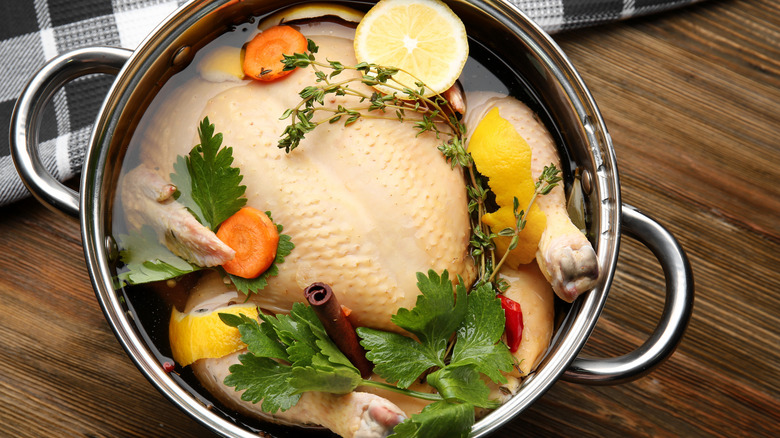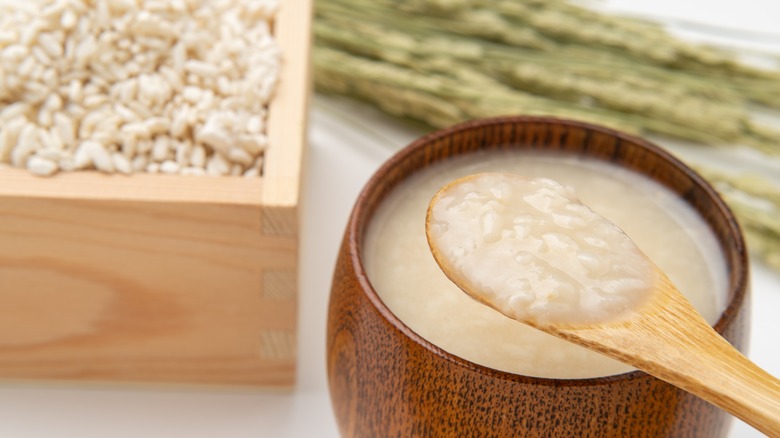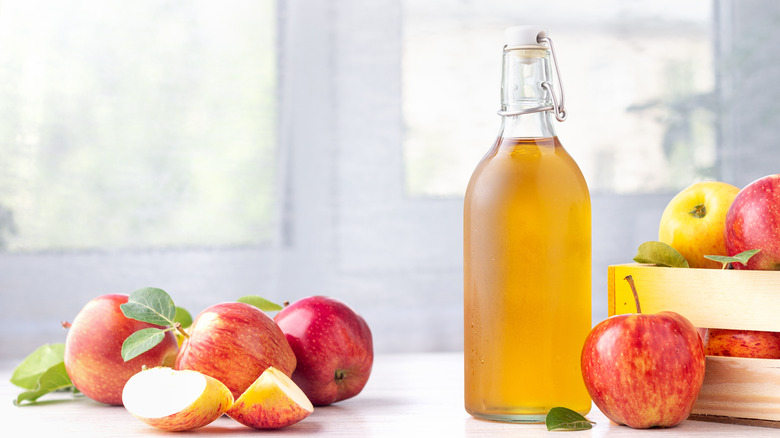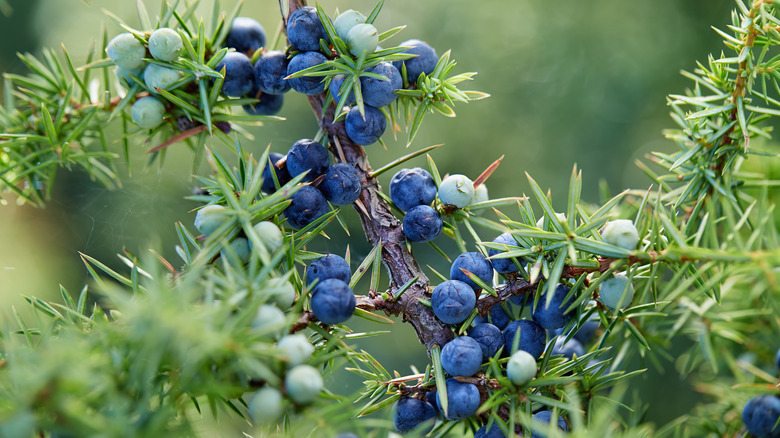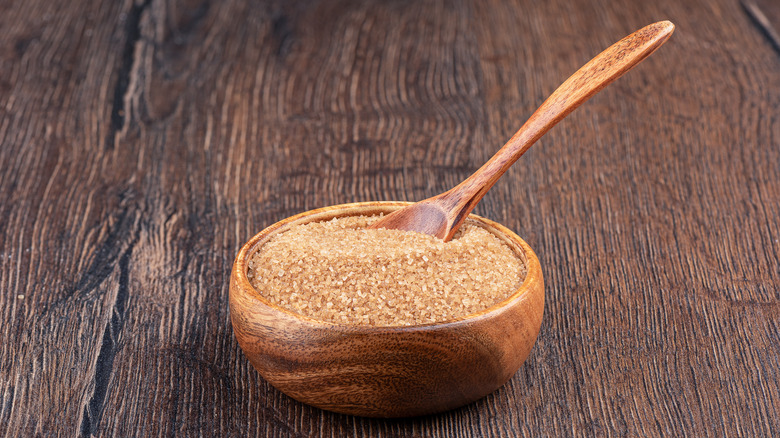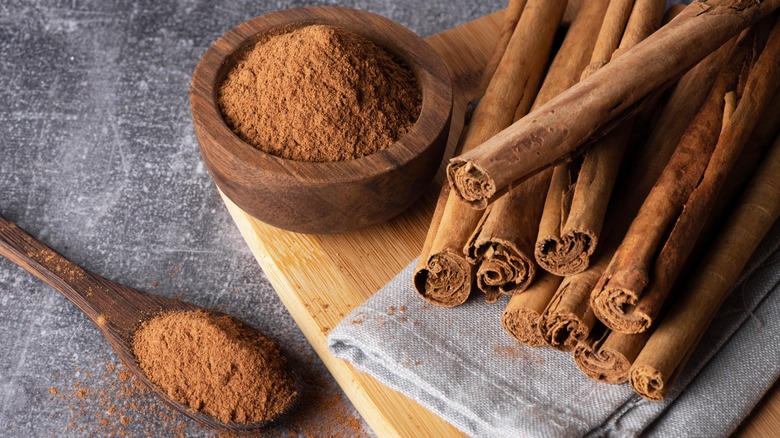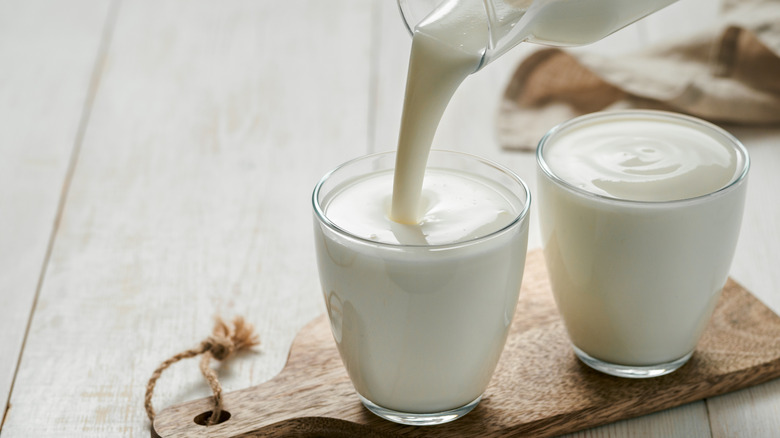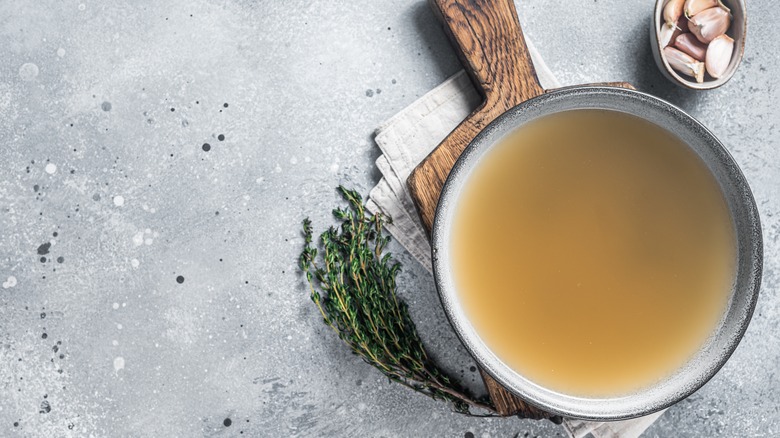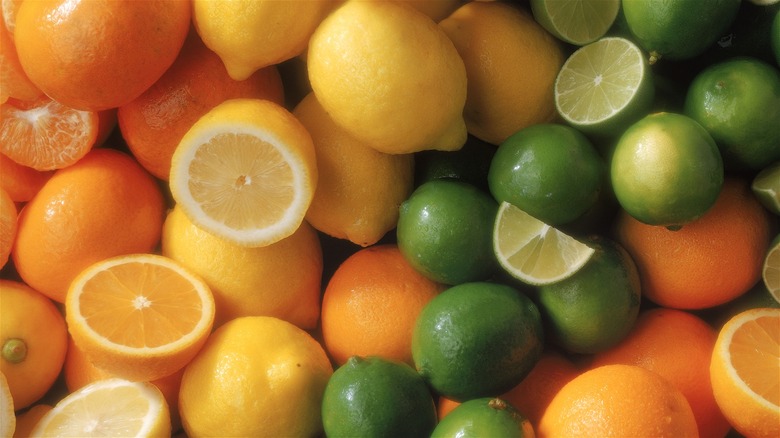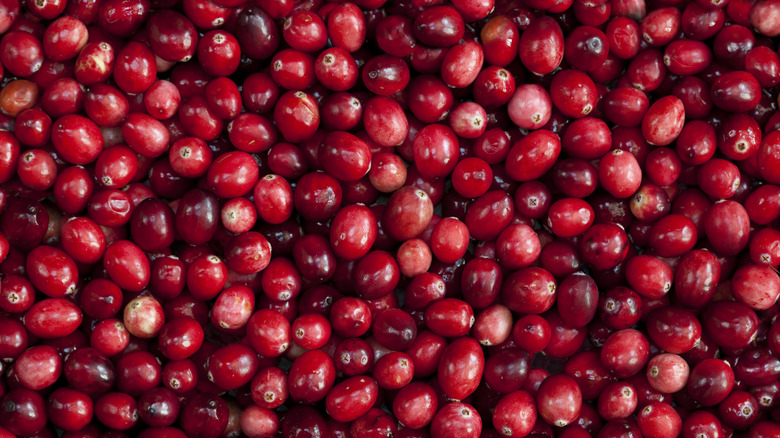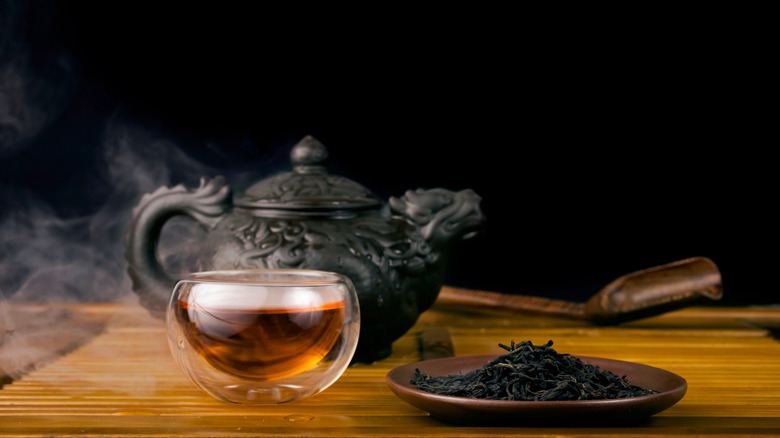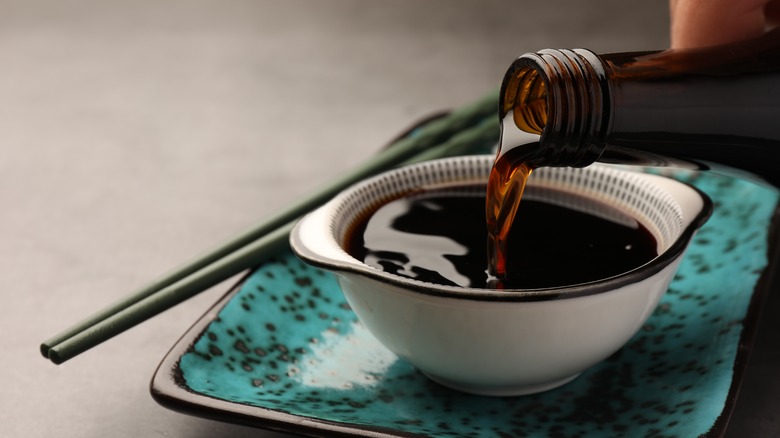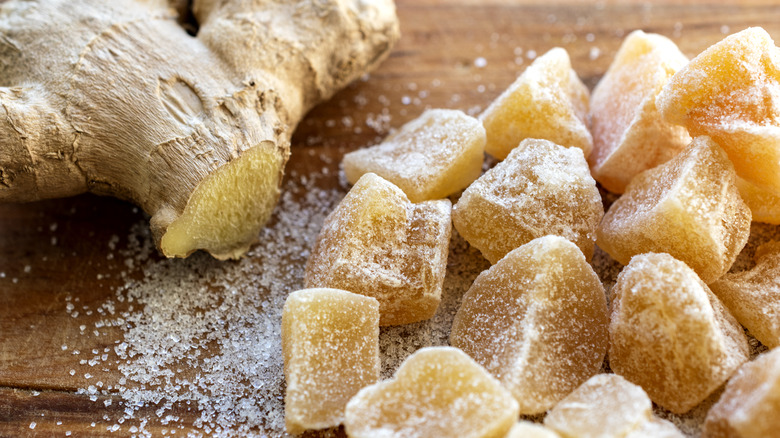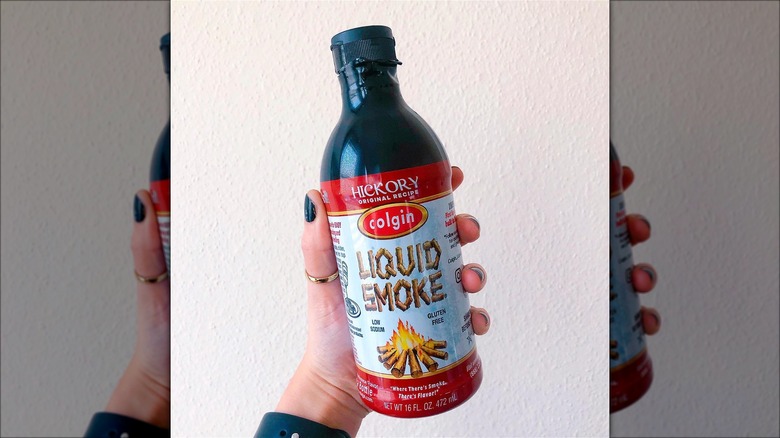Elevate Your Turkey Brine With These Unique Ingredients
It's an open secret that turkey, though delicious, has the tendency to be dry and tough, an outcome that can ruin a holiday meal no matter how much gravy and cranberry sauce you have on hand. There are many ways to prepare it, but regardless of whether you prefer roasting, deep-frying, or smoking this centerpiece of the Thanksgiving meal, brining, the process of soaking meat in saltwater, should be your first port of call. It is, quite simply, the key to the most tender, juicy bird you will ever produce.
Contrary to what you might assume, the added moisture isn't achieved by absorbing the water in the brine. It's the work of the other ingredient. The salt acts as a denaturing agent, weakening the lattice of coiled protein fibers in the meat. As the turkey cooks, the protein fibers contract, but because they are weaker, they do not squeeze out as much moisture as they normally would.
It's best to let your turkey soak for 12 to 24 hours to allow the salt to work its magic. One of the best ways to take advantage of the lengthy soaking time is to add flavorful ingredients to the salty solution. As the turkey sits in the liquid, it will absorb not only salt but whatever other ingredients you choose to add. We've rounded up a list of some of the best options to make your brine work overtime to create the most flavorful, succulent turkey you've ever tasted.
Koji
Koji is not a common ingredient in American households, but even if you haven't heard of this star ingredient from East Asia, it's likely that you've tasted it. Koji is the mold-inoculated grain that forms the foundation of umami-rich foods, including soy sauce, miso, and sake. It is made by combining a fungus called Aspergillus oryzae with steamed grains (usually soybeans or rice) and letting the mixture sit for multiple days, allowing the enzymes in the fungus to break down the carbohydrates and proteins in the grain. The resulting amino acids flood the koji with umami and sweetness, a combination that makes soy sauce, miso, and other koji-based foods so distinctive.
Luckily, you don't have to purchase mold spores in order to add the mouth-watering magic of koji to your turkey recipe. You can buy jars of pre-made koji (usually labeled as shio koji), which have been dried and mixed with water and salt. When added to brine, it imparts the umami flavor of soy sauce but also exerts its enzymatic powers on the meat, making it even more tender. The result is succulent meat packed with salty-sweet umami flavor. If this sounds too good to be true, let us wow you even further: provided you can get your hands on a jar of shio koji, it's one of the easiest additions you can make. All you have to do is blend the porridge-like substance into a smooth paste and mix it into the brine.
Apple cider
Apples are often paired with pork, but considering the fruit's association with fall, it's surprising that apple-roasted turkey isn't more common. Their sweetness adds a sugary note to the meat, while their acidity provides a subtle contrast with the rich skin and gravy. If you've ever swooned over mango chicken or drizzled maple syrup on bacon, this brine might become your new favorite way to make a turkey.
Although you can use apple juice, apple cider is full of warming spices that will inject the turkey with even more fall flavor. You can even make your own to kick it up yet another notch. Because the turkey must soak in the brine for at least 12 hours before cooking, making apple cider ahead of time probably won't interfere with your other Thanksgiving food preparations. You can customize it to suit your preferences, but a tried-and-true formula includes apple juice, orange juice, and cinnamon. You can add brown sugar if you want it a little sweeter or garlic if you want it more savory. Regardless of the ratio between water and apple cider, ensure there is about one cup of salt per gallon of liquid.
Juniper berries
Juniper berries are the berry-like cones produced by juniper trees. When fresh, they resemble small blueberries, but don't be mistaken — they pack a powerful flavor punch that will come as an unpleasant surprise for anyone expecting something sweet and mild. They have a pungent, almost bitter flavor that is reminiscent of the piny smell of evergreen trees, and you might recognize it as the base flavor of gin. Because of this, juniper berries aren't the kind of ingredient that you'd want to put in muffins or pancakes, let alone eat by the handful. Still, they do lend a deliciously spicy, woody taste to savory dishes when used in small quantities.
Aside from their all-important role in gin, you might encounter them in marinades, where their sharp, piney flavor makes a delicious contrast with rich, savory meat. Their intensity means that a little goes a long way. When making turkey brine, all you need is one or two tablespoons. Bring the brine to a boil to allow the juniper berries to steep in the liquid, and make sure to let it cool completely before adding the turkey and putting it in the refrigerator.
Sugar
First impressions are important, and when it comes to turkey, the first thing you notice is the skin. Is it browned and crispy or pale and rubbery? That coveted, crispy brown layer will make mouths start to water even before the aroma can reach anyone, and it is one of the elusive characteristics of the perfect turkey that many of us strive for in vain every year. It turns out that the secret is easier than you might think. It isn't basting or a high temperature; it's sugar. When exposed to the heat from the oven, the sugar will caramelize, darkening the turkey's skin and helping it become crispy. Dissolving it in the brine prevents it from burning, which, as many home cooks will know from experience, tends to happen when you sprinkle sugar or a sugar-based rub on top of the meat before cooking, especially when cooking it at high heat or for an extended period of time.
The addition also adds sweetness, balancing the saltiness of the brine and providing another layer of deliciousness to the mouth-watering meat. For a simple option that adds nothing but sweetness and browning, use white sugar. For a more caramelized flavor and color, opt for dark brown sugar. All you need is a quarter cup per gallon of water, but if you want a sweet-and-savory flavor profile, bump it up to one and a half cups.
Cinnamon
If you're using sugar or apple cider in your brine, you should consider adding cinnamon. Although it might conjure associations with pies and cookies rather than meat, this warming spice suffuses turkey with a woody, slightly sweet flavor that complements the sugar and adds layers of depth that cannot be achieved through the simple sweet-and-salty combination. Brines don't flavor turkey with the kind of intensity that rubs and marinades do. Brine is more subtle, suffusing the meat with flavor rather than coating it. Because of this, you can push the boundaries with your flavor choices. Adding cinnamon isn't going to make the bird taste like a pastry. It will simply add a subtle warmth that you probably wouldn't be able to place if you weren't the cook behind it.
When adding cinnamon to brine, it's best to use cinnamon sticks rather than cinnamon powder. Although powder will work, it imparts a stronger flavor that may stand out more than you'd like. The cinnamon sticks will infuse the brine with a gentle spiciness that won't overpower the other ingredients.
Buttermilk
Buttermilk is the unsung hero of many recipes and is far too often substituted with milk or yogurt. But just because it's a liquid dairy product does not mean it's interchangeable with any of the other ingredients in that category. Traditional buttermilk is the liquid that remains after cream has been churned into butter. Most buttermilk found on store shelves these days is made by adding live cultures to milk, similar to the process of making yogurt. Unlike yogurt, however, it has relatively low amounts of protein and lactose, and its acidity, therefore, comes with less baggage, making it the perfect leavening agent in baked goods when you want them to be light and airy rather than moist and dense.
The lactic acid in buttermilk also has a transformative effect on meat, tenderizing the outer layer without turning it mushy, the way ingredients with citric acid (most notably lemon juice) can. When it comes to using buttermilk to brine turkey, you don't even need water. Because brining is more about denaturing the protein fibers in the meat than soaking it in liquid, the combination of the acidic buttermilk and plenty of salt will do the trick without anything else. Use a brining bag so you can easily move the turkey around during the process to make sure it's coated in the salty buttermilk. When it's ready to go in the oven, shake off as much of the liquid as possible to avoid burning.
Vegetable or chicken stock
One of the easiest ways to inject a little more flavor into your brine without giving yourself extra work at a time of year when you're probably already planning to spend countless hours in the kitchen is stock. Rich in savory flavors, it's a simple ingredient that will intensify the flavor of your turkey without dressing it up with anything too distinctive. If you want your turkey to taste like the richest, most succulent roasted bird you've ever had and nothing else, stock is your secret weapon. You can make your own if you have the time or simply pick some up on your next trip to the grocery store.
Vegetable or chicken stock will work, but we recommend shying away from beef stock as its flavor is distinct enough from turkey to clash with it. Veggie stock tends to be a little sweeter and lighter, while chicken stock has a richer taste that will pair well with roasted turkey. Use a one-to-one ratio of water to stock for the brine, and make sure to scale back on the salt to compensate for the amount that's already in the stock.
Citrus
Citrus fruits offer a range of tart flavors, from the sweet-tartness of oranges to the pure tartness of lemons. When added to brine, their citric acid helps tenderize the meat, making a notoriously tough bird more palatable. It also acts as a flavor enhancer. That tightness that you feel in your jaw when you bite into a lemon is due to the production of saliva that acid induces. Saliva is a key player in our perception of flavor because it carries food to our taste receptors. Adding citrus to recipes not only imparts a citrusy flavor but also enhances the flavors of the other ingredients.
There is no wrong answer when it comes to choosing which citrus fruit to use in your turkey brine. Oranges provide sweetness, lemons provide brightness, and limes and grapefruits provide their own distinctive flavors. You can even do a little of each. Just make sure not to add too much. A high concentration of citrus juice can be so acidic that it over-tenderizes the meat, turning it mushy. Opt for one lemon or lime per gallon of water. If you're using orange juice, you can afford to use more as it is less acidic.
Cranberry juice
Cranberry sauce isn't the only use for the bright red berry when it comes to Thanksgiving cooking. When added to brine, cranberries provide their signature tartness and enough acidity to help tenderize the meat. Your guests will taste the familiar flavor, but it won't be strong enough for them to immediately identify it. Instead, the cranberry juice acts as a happy medium if you are trying to choose between apples and lemons. It's less sweet than apples and less acidic than lemons, creating the perfect balance.
Using cranberry juice instead of stewing whole berries will speed up the process. Opt for a two-to-one ratio of juice to water to ensure the flavor shines through, or just add cranberry juice concentrate to the prescribed amount of water. You can make the brine sweet and spicy by adding sugar, apple juice, cinnamon, and cloves, or take it in a more savory direction with herbs like thyme, rosemary, and bay leaves. You can even add garlic and lemon if you want it to taste like a classic roast chicken recipe.
Tea
Given their variety and similarity to dried herbs, it's strange that tea leaves are rarely used in cooking and baking. From the bold, malty notes of Assam to the gentle taste of chamomile, tea offers a wide range of flavors, and brine provides one of the best opportunities to explore its possibilities. In fact, given that it's a large quantity of water in which various ingredients are steeped, you could think of brine as a huge pot of tea, albeit salty and with a bird in it. Adding tea leaves has the benefit of giving your guests something that tastes unlike anything they've ever had, and because it only provides a hint of flavor, it isn't as much of a gamble as it might seem.
Many brine recipes that contain tea leaves use some form of black tea. This covers a broad range of flavors. If you're in the South (or were born there and are missing it), creating a sweet-tea-inspired recipe could be a winning choice, combining Assam or Darjeeling leaves with plenty of sugar and a hint of lemon juice. For an option that is the height of sophistication, find a store that carries Lapsang souchong, a Chinese tea that is smoked over a pinewood fire and imparts a deep, smoky flavor to the brine. Even if they can't identify the flavor, your guests will be begging to know the secret to your recipe.
Soy sauce
For a caramelized, umami-flavored turkey, a brine that includes both soy sauce and brown sugar is a must. Though made with koji, soy sauce does not have the same mild, nutty flavor as the inoculated grain paste, nor its tenderizing abilities. What it does have, however, is that intensely salty umami flavor that we just can't get enough of in stir-fries and noodle dishes. Despite one being the epitome of sweet and the other salty, brown sugar and soy sauce come together in perfect harmony due to their rich, earthy flavors. They also work together to add a slightly darker color to the turkey skin, no burning necessary.
You don't need to substitute all the water in a recipe for soy sauce (this would be far too salty). One 10-ounce bottle for two gallons is plenty, though you can increase the soy sauce proportion if you want a more pronounced umami flavor. As for the brown sugar, at least a half cup per gallon is necessary to achieve a caramelized flavor, though feel free to use more if you want it a little sweeter.
Candied ginger
For a bold approach to turkey brining, candied ginger distinguishes itself by providing sweetness and a subtle warmth that permeates the meat without overpowering it. While it may seem like an unconventional and even risky addition, Alton Brown once featured it in a turkey brine recipe on an episode "Good Eats," which, as far as we're concerned, makes it a mandatory ingredient choice.
Candied ginger differs from powdered ginger and fresh ginger in multiple ways. Like powdered cinnamon, powdered ginger has a greater surface area, making it a more pervasive flavor. If you want your turkey to have an identifiable taste of ginger, adding powdered ginger to the brine is a good move. But if you want it to meld seamlessly with the rest of the flavors, you should choose a different option. Fresh ginger has a fiery kick to it but loses its power when steeped in liquid. Candied ginger, on the other hand, offers a sweet-spicy heat that spreads more readily due to its sugar content, which helps to diffuse the ginger's pungent flavors throughout the brine as it dissolves. Just a few teaspoons provide a noticeable warmth to the turkey without becoming the defining flavor.
Liquid smoke
Are you looking for a decisive punch of flavor that will leave your guests marveling at your kitchen wizardry? Look no further than a humble (but mighty) bottle of liquid smoke, an ingredient that will let you present a perfect replica of a smoked turkey to your guests without having to, you know, do any smoking.
Liquid smoke isn't just a marketing spin. It is actual smoke that has been condensed into liquid. You might see it labeled as wood vinegar or smoke flavor as well. Given how strong smoke smells when it's in a gaseous state, you can imagine how powerful a flavor it is when it's condensed into liquid. With this in mind, tread lightly. All you need is a few tablespoons per gallon of water, though you can ramp it up to a quarter cup if you want to make sure the smoky flavor stands out. Add a little garlic, onion, and smoked paprika to round out the flavors, and pat yourself on the back for producing the impossible: a hassle-free "smoked" turkey.
